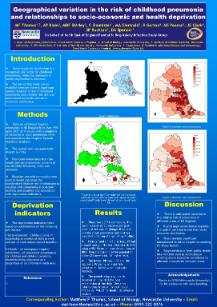The impact of a conjugate pneumococcal vaccine
|
Project Name |
The impact of a conjugate pneumococcal vaccine (Prevenar) on the epidemiology and aetiology of childhood pneumonia in the North East of England |
|
|
|
|
Dates |
12/10/2009 - 31/03/2011 |
|
Project Collaborators |
|
|
Funders |
Wyeth Vaccines (now Pfizer Inc.) Supported by NIHR UKCRN study portfolio (Proj. 7373) http://public.ukcrn.org.uk/Search/StudyDetail.aspx?StudyID=7373 |
|
Project Description
|
Pneumonia is a common childhood condition with a severity that may range from the very mild to severe requiring ventilatory support and even systemic disease and death. A previous study on children with pneumonia seen in hospital in the North East of England carried out during 2001–2002 established an incidence of 144/100,000 children per year (338/100,000 for those under 5 years). Eighty-nine per cent of the children assessed were admitted to hospital. Previous studies in America and Finland suggested that in children less than 2 years of age, Streptococcus pneumoniae causes up to 30% of pneumonia seen in hospital. Small studies in Britain have found evidence for pneumococcus in 20% and the previous local study suggested S. pneumoniae implicated in up to 28% of children presenting to hospital (unpublished data). The introduction of a new conjugate vaccine against S. pneumoniae, which is highly effective against invasive bacteraemia and meningitis in young children, has been found to decrease lobar pneumonia by 35% in the USA. In order to understand the epidemiology of both empyema and pneumonia better, and to study the impact of the expected changes in the pneumococcal vaccination programme, it will be important to determine what proportion of pneumonia in children admitted to hospital is related to infection with S. pneumoniae, other bacteria or viruses. Aims:
Objectives:In a group of children aged less than 16 years with pneumonia presented or admitted to hospitals in the North East of England, to:
3. Establish a bacterial pathogen in a subgroup of children using culture, serology, PCR, and urine antigen detection in order to:
|
|
|
ERS Poster 2011 PDF 685Kb
